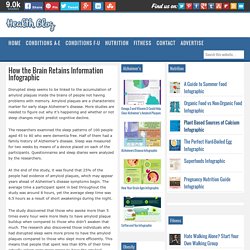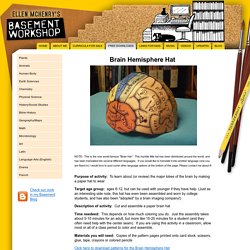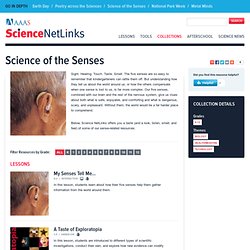

How the Brain Retains Information Infographic. Disrupted sleep seems to be linked to the accumulation of amyloid plaques inside the brains of people not having problems with memory.

Amyloid plaques are a characteristic marker for early stage Alzheimer’s disease. More studies are needed to figure out why it’s happening and whether or not sleep changes might predict cognitive decline. The researchers examined the sleep patterns of 100 people aged 45 to 80 who were dementia free. Half of them had a family history of Alzheimer’s disease.
Sleep was measured for two weeks by means of a device placed on each of the participants. At the end of the study, it was found that 25% of the people had evidence of amyloid plaques, which may appear years ahead of Alzheimer’s disease symptoms begin. The study discovered that those who awoke more than 5 times every hour were more likely to have amyloid plaque buildup when compared to those who didn’t awaken that much. Copy and paste the code below to embed the full size image on your site: Pinterest. Much better than the one in my textbook. Loom Junior. Brain Hemisphere Hat (made of paper) NOTE: This is the now world-famous "Brain Hat.

" This humble little hat has been distributed around the world, and has been translated into several different languages. If you would like to translate it into another language (one you are fluent in) I would love to post some other language options at the bottom of this page Please contact me about it! Purpose of activity: To learn about (or review) the major lobes of the brain by making a paper hat to wear Target age group: ages 8-12, but can be used with younger if they have help (Just as an interesting side note, this hat has even been assembled and worn by college students, and has also been "adopted" by a brain imaging company!) Description of activity: Cut and assemble a paper brain hat Time needeed: This depends on how much coloring you do.
Materials you wiil need: Copies of the pattern pages printed onto card stock, scissors, glue, tape, crayons or colored pencils Click here to download patterns for the Brain Hemisphere Hat. Brain and Memory. Nervous System Diseases. Science of the Senses. Sight.

Hearing. Touch. Taste. Smell. The five senses are so easy to remember that kindergarteners can rattle them off. Below, Science NetLinks offers you a taste (and a look, listen, smell, and feel) of some of our sense-related resources. Filter Resources by Grade: Lessons Tools 3-8 | Interactive Test your reaction time with this interactive game! Science Updates Afterschool Resources K-5 | Hands-On Sound travels—not just through air, but through liquids and solids, too. Sixth, Seventh, and Eighth Grade Lesson Boosters for any ...
scienceofeverydaylife.discoveryeducation.com/teachers/pdfs/6_8_BRAIN.pdf. Minute to Win It…Fun collection of games (and photos) ... Function of Neurotransmitters. Explore the nervous system. 125 Great Science Videos: From Astronomy to Physics & Psychology. Astronomy & Space Travel A Brief, Wondrous Tour of Earth (From Outer Space) - Video - Recorded from August to October, 2011 at the International Space Station, this HD footage offers a brilliant tour of our planet and stunning views of the aurora borealis.A Universe from Nothing - Video - In 53 minutes, theoretical physicist Lawrence Krauss answers some big enchilada questions, including how the universe came from nothing.A Year of the Moon in 2.5 Minutes - Video - The Lunar Reconnaissance Orbiter has been orbiting the moon for over a year.

The footage gets compressed into 2 slick minutes.A Day on Earth (as Seen From Space) - Video - Astronaut Don Pettit trained his camera on planet Earth, took a photo once every 15 seconds, and then created a brilliant time-lapse film.Atlantis's Final Landing at Kennedy Space Center - Video - After more than 30 years, the space shuttle era comes to a close.
Video runs 30 minutes. Physics Biology & Chemistry Environment, Geology and & Ecology. The Brain and Senses. Welcome to the Brain and Senses!

Hi, we are Dr Ellen Poliakoff and Dr Luke Jones and we’re experimental psychologists. This means that we find out how people think and how the brain works. When we are not teaching - or lecturing as it's called at University! - we can be found doing experiments in the laboratory. www.brentbarson.com/verite/kyb/000_kyb_v4.swf. 50 Brain Facts Every Educator Should Know. January 27th, 2010 By Pamelia Brown The brain is perhaps the most fascinating organ in the human body. It controls everything from breathing to emotions to learning. If you work with children, here are some facts that you might find helpful, from how the brain affects learning to facts about memory to interesting facts about the brain that you can share with your students.
Brain Development and Learning Read on to learn interesting facts about how the brain develops, what can affect that development, and how learning is impacted. Read aloud. The mysterious workings of the adolescent brain - Sarah-Jayne Blakemore. How do nerves work? - Elliot Krane. Molecular mechanism of synaptic function. Is It Possible?- Real Life Batman. Twin Super Powers.